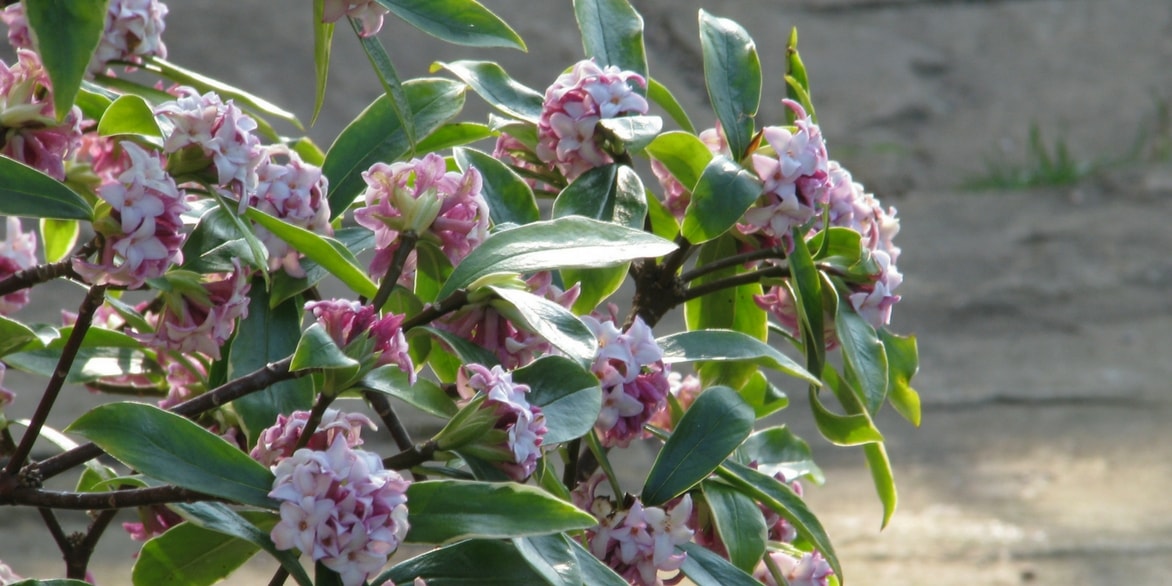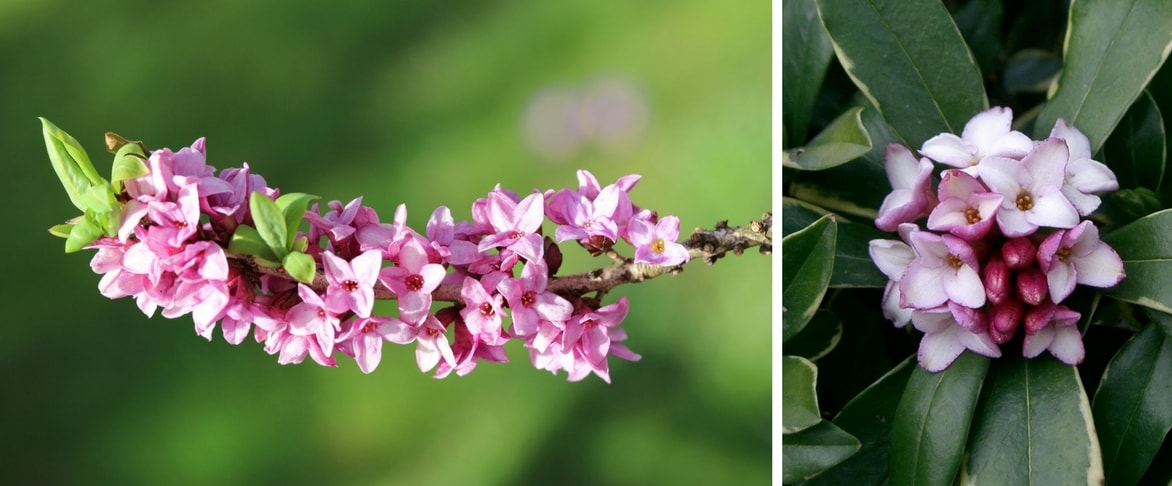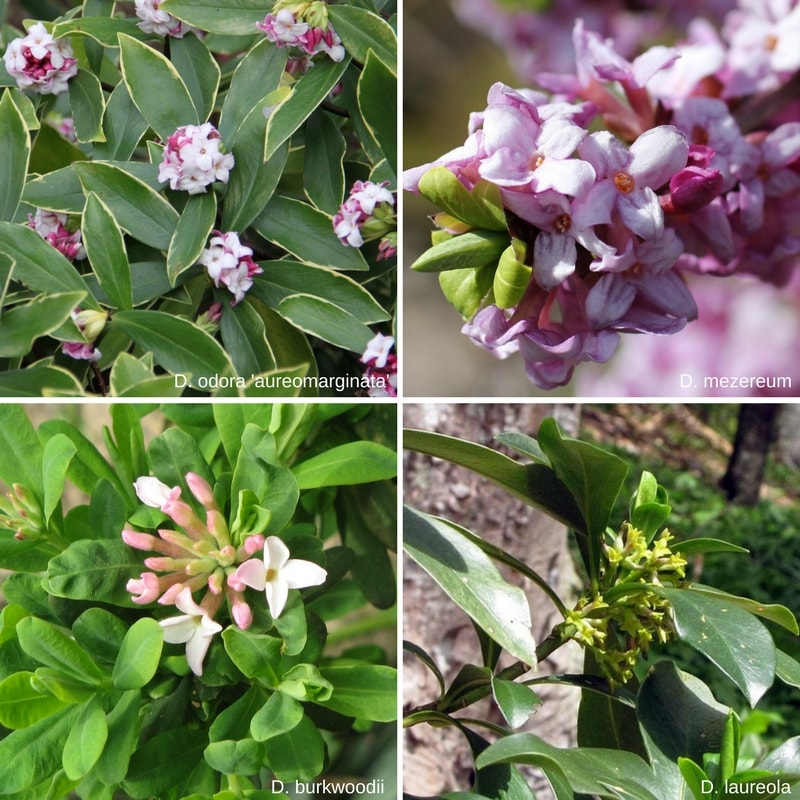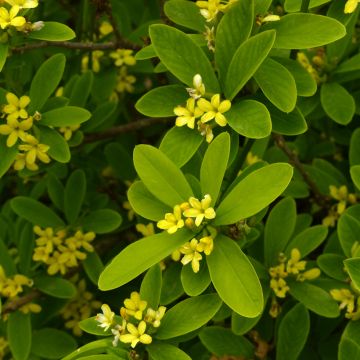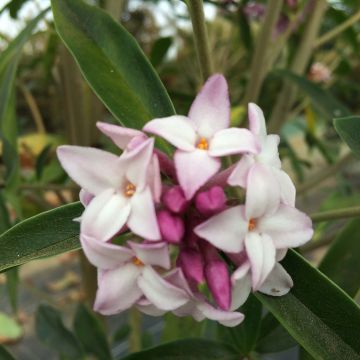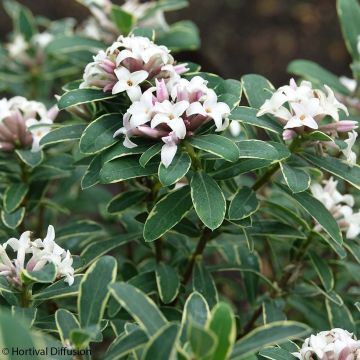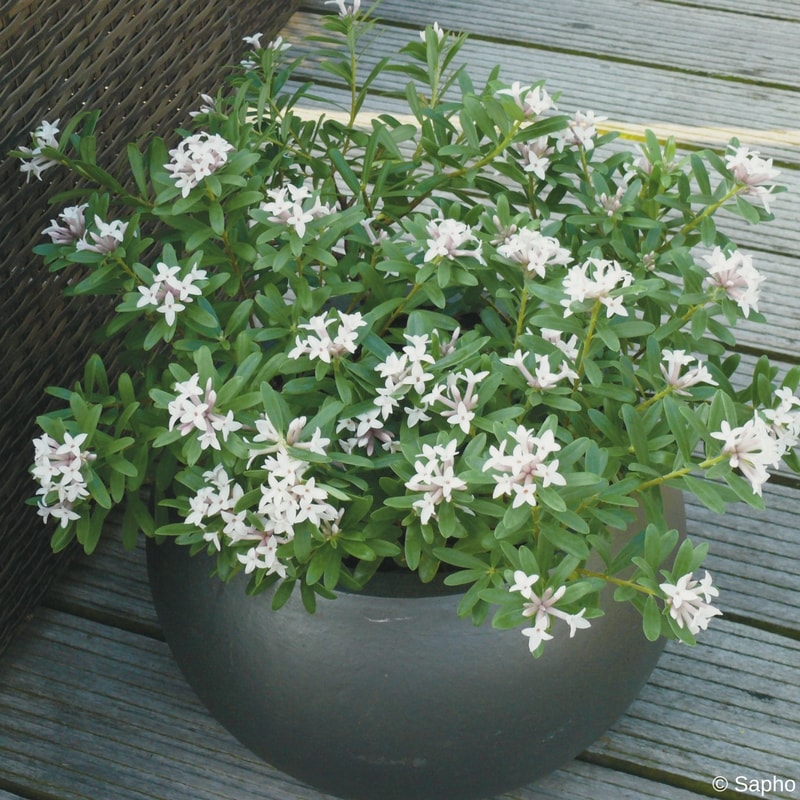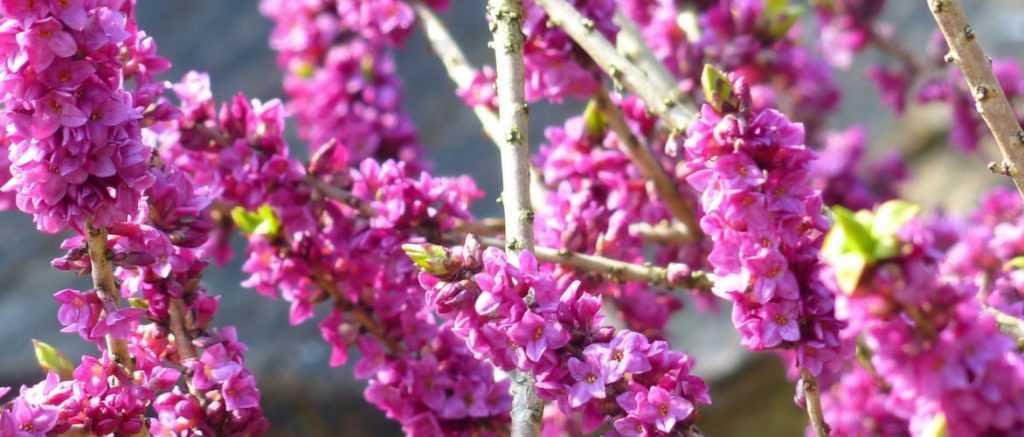
Daphne: How to Plant, Grow and Care for It
Contents
Daphne in a Nutshell
- In the heart of winter, its flowers release a powerful fragrance that perfumes the garden up to 20 metres around
- Its glossy green foliage is evergreen, semi-evergreen or deciduous depending on the species
- It’s a must-have for shady or partially shaded gardens
- It requires fresh, humus-rich and well-drained soil, needing some attention as it’s sensitive to waterlogging
- With very slow growth and compact size, it’s ideal for small gardens, urban gardens and thrives in containers
Our expert's word
Daphne, also known as Mezereon or Spurge Laurel, is a hardy shrub with delicate star-shaped white or pink flowers that emit an exceptional fragrance.
If Daphne takes its name from the nymph of Greek mythology transformed into a laurel tree, it’s because its divine scent is utterly enchanting.
Indeed, the Daphne odora, the most fragrant of all Daphnes, releases a highly floral scent reminiscent, depending on the nose, of carnation, jasmine, or even hyacinth—all blended with citrus and spiced with a hint of clove. A deliciously complex fragrance that carries several metres around!
Still relatively unknown, Daphnes are nonetheless among the few winter-flowering shrubs, alongside Sarcococca and Witch Hazel. And while the Daphne mezereum blooms as early as February, others like the Daphne (x) transatlantica wait until June.
But its generous flowering isn’t its only asset! Its glossy, leathery foliage can remain evergreen in mild winters.
Relatively adaptable in light, acidic, well-drained soil, Daphne thrives in the shade of trees, sheltered from waterlogging, cold winds, and excessive heat.
Slow-growing and compact, it’s an ideal shrub for small gardens and urban spaces. Its diverse family includes dwarf varieties, perfect for cool rockeries, as well as taller species reaching up to 1.5 metres in height and spread.
Its modest size and dense shape make it versatile—suitable for borders, hedges, flowerbeds, ground cover, and even containers.
While the perfect spot to enjoy its powerful fragrance is near the house, it also excels in neglected, shady areas where few plants bloom. It pairs beautifully with shade-loving and ericaceous plants, as well as those with contrasting foliage: camellias, ferns, witch hazels, skimmias, aucubas, or azaleas, alongside hellebores, snowdrops, crocuses, and daffodils.
In winter or spring, Daphne transforms the garden with its exquisite perfume. Discover this remarkable shrub!
Botany
Botanical data
- Latin name Daphné
- Family Thymelaceae
- Common name Bois-joli, Bois-Gentil
- Flowering très parfumée, de février à octobre selon les variétés
- Height 0,80 à 4 mètres
- Exposure Mi-ombre, ombre
- Soil type Terre de Bruyère (Acide), neutre
- Hardiness - 15 °C
The Daphne, nicknamed “Bois Joli” or “Bois Gentil”, is a cousin of the “Garou” found in our mountains. This shrub belongs to the Thymelaeaceae family, native to Europe, North Africa and temperate Asia. It grows in woodlands, thickets or mountainous areas.
Around fifty species of shrubs with deciduous, evergreen or semi-evergreen foliage make up the genus, but only a few species are cultivated in France, including: Daphne mezereum, extremely hardy down to -30°C, Daphne cneorum, an equally hardy dwarf variety, Daphne laureola, which remains green all year round, the tall Daphne x burkwoodii, Daphne alpina, and the most famous, Daphne odora or fragrant Daphne, which is a protected species in France. The latter is also the most fragrant of all Daphnes, particularly its famous cultivar ‘Aureomarginata’.
This rather diverse family includes creeping and ground-covering varieties like Daphne cneorum which doesn’t exceed 20cm in height at maturity, while taller species like Daphne x burkwoodii can reach up to 1.5 metres in height with a similar spread.
With very slow growth, Daphne is a compact shrub that’s well suited to small gardens. It has a relatively short lifespan for a shrub, living 15 to 30 years depending on the variety.
The habit of this small shrub varies by species: open with upright branches, bushy and rounded, sometimes spreading or prostrate. The more or less branched silhouette bears thick, flexible stems. Daphne takes some time to establish itself: the plant develops its roots very slowly in the soil. Nevertheless, it’s not one of those shrubs you forget about – its powerful fragrance makes sure of that!
Remarkably floriferous, Daphne blooms, depending on species and variety, in winter, spring or summer. Some are very early, with flowers opening as soon as February (Daphne mezereum var.‘ rubra’, Daphne odora ‘Aureomarginata’), while others wait until spring is established in April-May to appear.
It bears delicate small star-shaped flowers with four fleshy, pointed petals curving outward, somewhat reminiscent of jasmine flowers. In shades of candy pink, white, yellow, purple, red, lavender or lilac, they appear before the leaves and cluster at the ends of bare stems in large umbels that can bear up to thirty flowers. A well-established plant will produce up to 10 flower clusters on each stem.
Most Daphnes are highly fragrant, emitting complex scents that are both sweet and rustic. These powerful fragrances with exotic notes recall carnation, jasmine and hyacinth, enhanced with spicy clove and citrus undertones.
Depending on variety, this exceptional flowering may pause in July-August, then return more or less discreetly in late summer around September-October, offering flowers for about 6 months of the year. This extended flowering period perfumes the garden up to 20 metres away and lasts several weeks.
Daphne foliage is evergreen, semi-evergreen or deciduous depending on species. Alternate, simple and leathery, smooth to downy, dark green or glossy green, oval to lanceolate, the leaves are a few centimetres long for dwarf species or nearly 10cm for taller varieties. Measuring 1 to 2.5cm wide, they cluster in rosettes at branch tips before spreading along the length of new stems. Some cultivars feature attractive dark green leaves variegated or margined with yellow, while others have dense foliage resembling laurel.
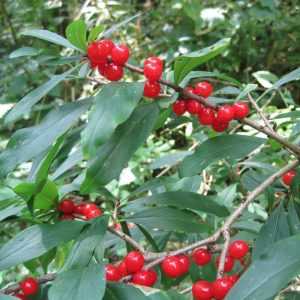
Daphne fruits: toxic berries
The poisonous red fruits develop after flowering on the previous year’s leafless stems: these decorative berries – bright red like currants, white, orange or purple-black – are toxic if ingested. As they could be mistaken for edible fruits, we advise caution if you have young children.
This woodland dweller thrives in partial shade and prefers shaded locations or filtered sunlight through trees. Daphne laureola tolerates deep shade. Daphnes are perfect for north or northeast-facing gardens. A spot protected from spring frosts and cold winds is ideal.
It grows well throughout France, except perhaps in Mediterranean climates: it dislikes extreme heat and scorching sun. It thrives in mild, humid climates like Brittany’s.
Although Daphnes generally show good hardiness (surviving frosts down to -10°C to -15°C), it’s best to protect them from severe cold. Intense frost may cause leaf drop until new foliage appears in spring.
Less finicky than Kalmia but more vulnerable than Sarcococca, Daphne isn’t very difficult to grow… provided it’s planted in suitable soil: light and acidic. It will then flower for many years with minimal care. It prefers well-drained, cool and light soils. Very sensitive to excess water, it dislikes waterlogged heavy, compact soils. A neutral or slightly acidic soil, humus-rich but not overly fertile suits it perfectly. Species like D. mezerum or D. cneorum tolerate lime, while D. odora is typical of heathland soil.
Remember that moderation is key: soil that’s neither too wet nor too dry, sunlight that’s filtered rather than direct, humus-rich soil without excessive fertilisation… With Daphne, it’s all about balance!
The different species
There are around fifty varieties of Daphne worldwide, but only a few species in France, which can be divided into low-growing dwarf Daphnes and taller species.
Dwarf Daphnes
Compact, dwarf species (10–50 cm tall) are perfect for cool rockeries or container growing:
- Daphne alpina or Alpine Daphne: A deciduous, very hardy species found in rocky limestone areas of the Jura, Alps, and Pyrenees. Its fragrant white flowers appear from April to June after the leaves. It has a low-growing habit, reaching 20–50 cm in height.
- Daphne cneorum or Garland Flower: This low-growing shrub is characterised by its prostrate form and fine evergreen foliage, rarely exceeding 30 cm in height. In April–May, clusters of carmine-pink flowers with a strong carnation-like fragrance appear.
- Daphne sericea: With its compact or spreading, rounded form and evergreen foliage, it is ideal for borders or rockeries. In May, fragrant, purple-pink flowers (fading as they age) bloom with a carnation-like scent.
- Daphne arbuscula: This semi-prostrate dwarf shrub (10–15 cm tall) has evergreen leaves and abundant dark pink flowers in May–June.
- Daphne jasminea: A semi-prostrate, highly branched evergreen species bearing delicate, fragrant white star-shaped flowers.
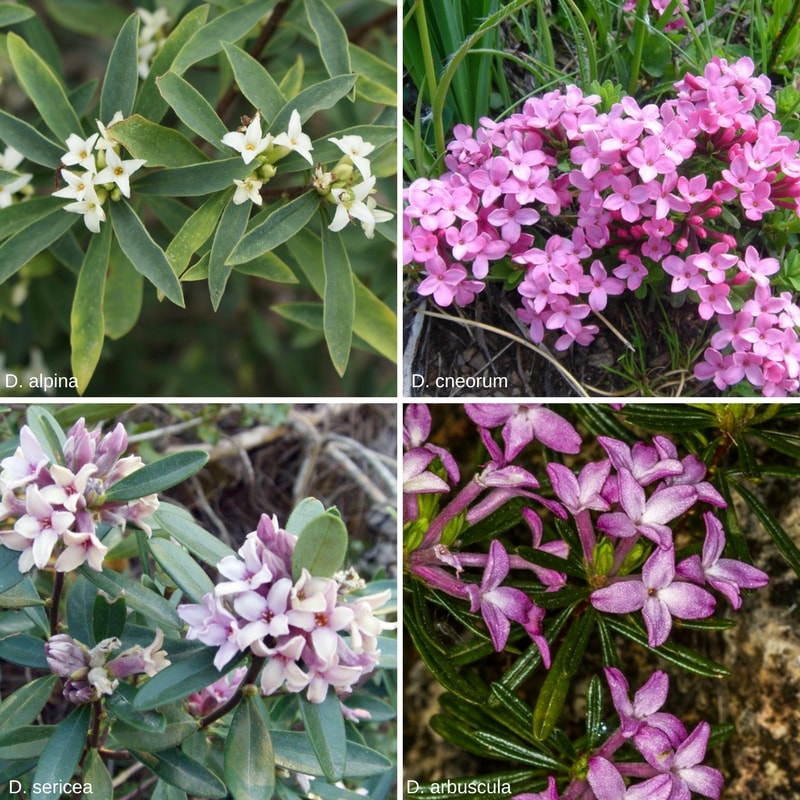
Different species of dwarf Daphnes
Taller Species
These are perfect for heather beds or as standalone specimens, but to enjoy their fragrance, it’s best to plant them near the house or a pathway.
- Daphne odora or Winter Daphne: The most fragrant and one of the earliest-flowering Daphnes. This spreading shrub (1.20–1.50 m tall) produces highly fragrant pink flowers at the tips of its branches from January to March. It is very frost-sensitive—its evergreen foliage struggles in harsh winters. Best suited to mild climates. Varieties include white-flowered Daphne odora ‘Alba’ and gold-margined foliage with light pink to purple-pink flowers (Daphne odora ‘Aureo Marginata’). This cultivar can withstand temperatures down to -10°C and thrives in ericaceous soil, ideal for north or north-east-facing positions.
- Daphne mezereum: Smaller than Daphne odora (rarely exceeding 1 m), but much hardier. Before its deciduous leaves emerge, it blooms from late February to March with upright clusters of lilac-pink, highly fragrant flowers. The flowers grow only along part of the stem, giving the plant a unique appearance. It bears red berries in summer. Daphne mezereum ‘Rubra’ is its most famous cultivar, with deep purple-pink flowers and an intoxicating fragrance.
- Daphne x burkwoodii: A compact, semi-evergreen shrub, one of the tallest (up to 1.50 m). Its fragrant light pink flowers appear in May. It is vigorous and very hardy.
- Daphne laureola or Spurge Laurel: Ranging from 40 cm to nearly 1.20 m tall. Its main appeal lies in its highly decorative, glossy evergreen foliage. Its yellow-green flowers last a long time.
The varieties
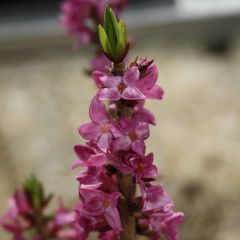
Daphne mezereum var. rubra
- Flowering time March, April
- Height at maturity 1,20 m
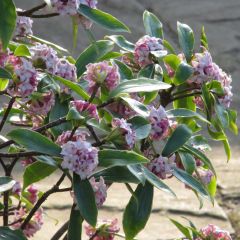
Daphne odora Aureomarginata
- Flowering time March, April
- Height at maturity 1,50 m
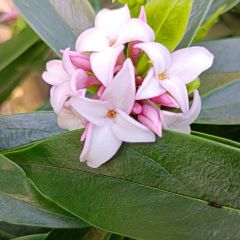
Daphne Perfume Princess
- Flowering time February to May
- Height at maturity 1,20 m
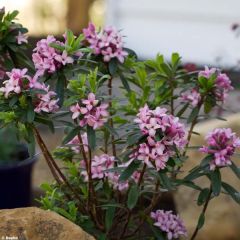
Daphne x bholua Spring Beauty
- Flowering time June to November
- Height at maturity 80 cm
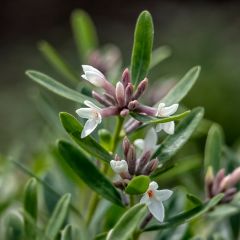
Daphne transatlantica Eternal Fragrance Blafra
- Flowering time June to December
- Height at maturity 80 cm

Daphne odora Aureomarginata
- Flowering time March, April
- Height at maturity 1,50 m

Daphne transatlantica Eternal Fragrance Blafra
- Flowering time June to December
- Height at maturity 80 cm
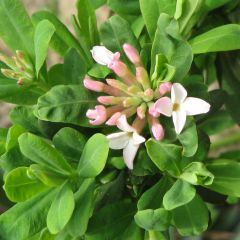
Daphne burkwoodii Somerset
- Flowering time June, July
- Height at maturity 1,50 m
Discover other Daphne
Planting
Where to plant?
Daphne can be planted almost anywhere in France, except perhaps in Mediterranean climates, as it dislikes both extreme heat and scorching sun. It thrives in mild, humid climates, like that of Brittany. Slow-growing, Daphne is a compact shrub that is well-suited to small gardens or urban gardens.
Daphne takes time to establish. It does not tolerate transplanting well, so it’s best to choose a permanent spot for it.
It grows best in a shady corner of the garden: it will flourish in partial shade, sheltered from direct sunlight, at the base of trees that provide beneficial coolness. It prefers an open position rather than being sheltered by a wall—it also needs good air circulation. Daphne is perfect for north or north-east-facing gardens.
It is not difficult to grow if you have light, slightly acidic soil.
Plant it in moist but well-drained soil, sheltered from cold draughts. It thrives in humus-rich, neutral to slightly acidic soil… What it dislikes is heavy, compacted, waterlogged soil. Note that some species, such as D. mezereum, tolerate chalky soil perfectly well.
Daphne works well in borders, as a standalone specimen, or in pots. Plant taller varieties in a wooded or sheltered spot to fill out a hedge, and low-growing varieties in rockeries or along partially shaded borders. Plant it near the house to enjoy its fragrance to the fullest.
In pots, it makes a lovely year-round decorative feature if you choose compact varieties with glossy evergreen foliage, such as Daphne alpina, Daphne arbuscula, or Daphne jasminea.
When to plant?
Daphne is best planted in autumn in regions with mild winters, or in spring elsewhere in the country, particularly in northern France.
How to plant Daphne?
Since Daphne dislikes transplanting, you will only find young plants in nurseries. Planting is straightforward but requires a few precautions to ensure successful establishment:
- Dig a wide hole, at least three times the size of the root ball.
- Take care not to break the root ball when planting.
- If needed, add gravel to the bottom of the hole for good drainage (its roots dislike waterlogging and are particularly susceptible to Phytophthora attacks), about 20 cm deep. Mix well-rotted compost or ericaceous compost with garden soil.
- Apply an organic mulch or plant small perennials around the base to protect the roots and reduce watering needs: it likes its roots to stay cool in summer.
- Water well at planting and for the first two years while it establishes, but avoid overwatering. Occasional summer watering is sufficient during prolonged dry spells when temperatures exceed 25°C. Once well-rooted and mulched, it becomes fairly drought-resistant.
Container gardening
Daphnes are stunning in pots! Choose evergreen varieties with very compact forms such as Daphne alpina, Daphne arbuscula, Daphne jasminea, Daphne petrea. It is essential to use a rich, moist yet very well-draining soil mix, as they cannot tolerate waterlogged conditions. Select a large container of around 30 litres from the outset, as these sensitive plants dislike being repotted. When grown in pots, they won’t tolerate even brief periods of drought. Potted Daphnes require year-round watering, ensuring the soil dries out for at least 24 hours between waterings in summer. In winter, they can handle drier conditions—space out waterings to every three weeks. Fertilisation from the second year of growth is beneficial.
→ Learn more about growing Daphne in pots in our advice guide!
Maintenance and Pruning
Once the Daphne is well established, it requires very little care. To maintain the fertility of the substrate, you can incorporate a little compost each year by lightly scratching the surface around its base. Then remember to spread a good layer of organic mulch to keep its roots cool during the summer heat.
Slow-growing, it doesn’t require pruning. Only intervene to remove any dead branches or to slightly reduce its size. But beware, be aware that severe pruning won’t be tolerated and could, in the worst case, cause the death of the entire plant.
Potential diseases
Daphne has moderate resistance to diseases but is particularly susceptible to fungal infections. Its main enemy: Phytophthora, a soil-borne fungus whose attack can kill the plant as suddenly as it is devastating.
Phytophthora, literally meaning “plant destroyer” in Greek, thrives in persistently damp conditions caused by overwatering, combined with temperatures around 15-16°C. The rot enters through the crown and roots, preventing them from fulfilling their essential role of supplying water and nutrients. As a result, the foliage discolours, turns brown or red, then withers. The plant dies rapidly. There is no cure, but these issues are rare if proper cultivation advice is followed: plant in healthy soil, avoid waterlogged conditions, and improve drainage. If, despite these precautions, an attack occurs: remove affected plants and the surrounding soil. Never replant susceptible species in the same spot.
Additionally, Daphne may occasionally fall victim to Marssonina daphnes, a virus that also causes rapid plant death. It can be treated by spraying a fungicide in spring.
Propagation
If your shrub bears fruit, you can attempt sowing, but it’s a difficult operation to succeed with and one we wouldn’t recommend.
- By layering
Layering is the simplest and least tedious method for propagating Daphne, though it is very time-consuming. In spring, bend one of its stems towards the ground, burying a portion to encourage rooting. Stake the aerial part. By late summer, you can separate the layer from the mother plant if it has developed sufficient roots by cutting the stem where it enters the soil.
- By cuttings
Since Daphne’s lifespan can be abruptly shortened by Phytophthora attack, remember to take cuttings regularly. After flowering, in August-September, take semi-hardwood or semi-ripe cuttings 10-20 cm long (i.e., from stems that grew in spring and begin transitioning from softwood to hardwood around July-August). Plant them in a light, well-draining growing medium. Mist the cuttings regularly. Pot them up once roots have formed. Overwinter them frost-free: a constant temperature of at least 20°C is essential for rooting within 8-10 weeks. Plant out in the following spring.
Pairing Daphne
Plant it alongside early bulbs and shade-loving plants such as Ferns, Heathers, Heucheras, or Ophiopogons.
Daphne works equally well in borders, as a standalone specimen, or in large containers. Plant taller species in dappled shade in a woodland or sheltered spot, while low-growing varieties (Daphne alpina, Daphne arbuscula, or Daphne jasminea) thrive in cool rockeries or along bed edges. Pair it with non-invasive ground covers like Pachysandra terminalis to help retain moisture. Position it near the house to fully enjoy its fragrance. It’s ideal in an ericaceous bed alongside other Daphnes, Autumn Camellias, Deciduous Azaleas, and Hydrangeas. For an elegant display, combine it with a small Japanese Maple and Ferns—or for something striking, pair it with Leptospermum ‘Karo Pearl’ and Calycanthus ‘Venus’. Underplant with heathers and early-flowering bulbs (Winter Aconite, Narcissi, Crocus) for a harmonious, blooming carpet.
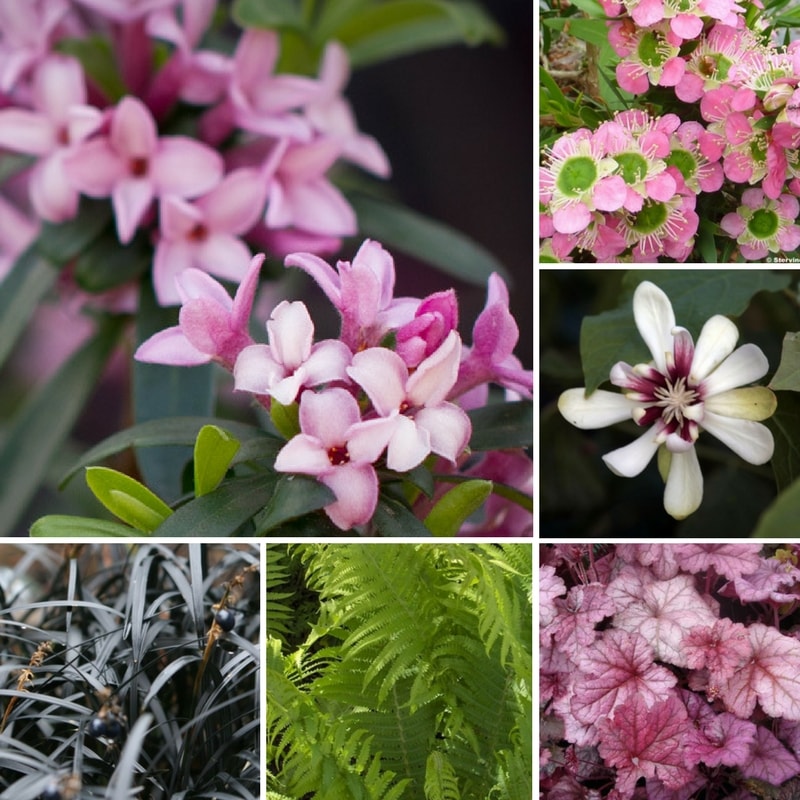

A striking combination: Daphne x transatlantica ‘Pink Fragrance’, Leptospermum ‘Karo Pearl Star’, Calycanthus ‘Venus’, and at ground level: Ophiopogon planiscapus, Dryopteris filix-mas, and Heuchera ‘Berry Smoothie’
Lastly, don’t hesitate to bring its enchanting fragrance indoors—its flowering stems make exquisite additions to spring bouquets, mingled with branches of Japanese Quince or flowering cherries.
→ Explore more Daphne pairing ideas in our expert guide!
Useful resources
- Discover our stunning range of Daphnes: we have the most beautiful varieties!
- Our advice sheets: how to plant ericaceous shrubs and Daphne odora: care advice
- Read Hortus Focus article “Daphnes: winter fragrance!”
- Watch our video about Daphne ‘Spring Beauty’
- Learn more about toxic shrubs in our advice sheet
Frequently asked questions
-
My Daphne looks healthy but isn't growing, is this normal?
Yes, that's normal. It's one of those plants that takes its time to establish... and then grows very slowly. A minor drawback that's more than compensated for by its fragrance and the fact that it requires no pruning.
-
My Daphne has lost its leaves after a heavy frost – what should I do?
If the weather is expected to be milder in the coming days, water it (but sparingly) and wait: it should recover in spring. In the future, to avoid this unnecessary stress, remember to protect it if temperatures are forecast to drop below -5°C, as this will help it retain its foliage.
-
The leaves on my Winter Daphne are turning yellow, why?
It may well be suffering from chlorosis... The soil is too chalky for it, so it would be best to move and replant it... if that's still possible.
-
Is my Daphne losing its leaves after planting serious?
If it only loses a few lower leaves, it's not serious. If the problem worsens, the soil may be too heavy or the plant may be exposed to excessively strong sunlight. Don't wait too long - move it. If the soil is very free-draining and dry: water it.
-
My daphne looks a bit unbalanced visually. Can I prune it?
A light pruning is possible, particularly to remove dead wood or to restore an attractive shape. However, be careful, as it is sensitive at both the roots and branches! Severe pruning risks causing sudden dieback of the shoots, or even the entire plant.
- Subscribe!
- Contents


































